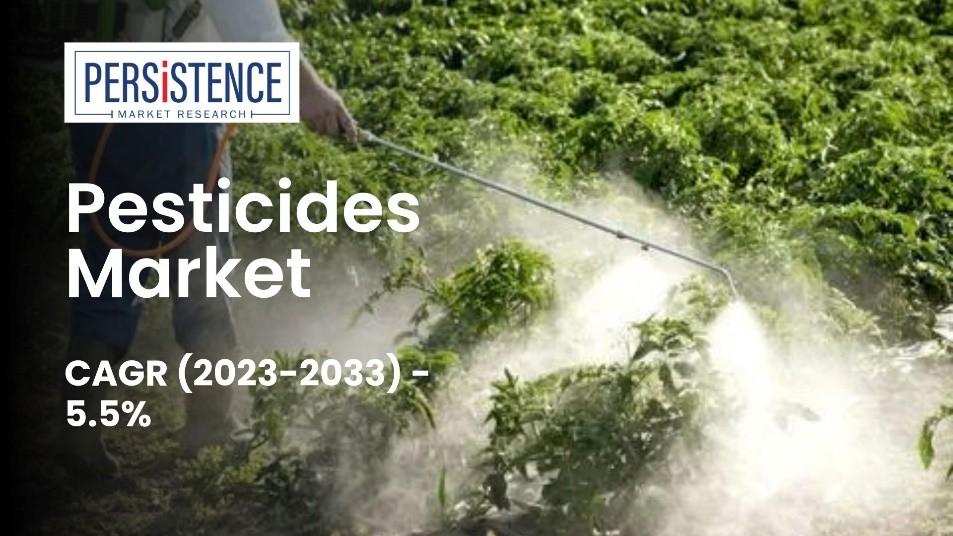Bio-Pesticides Gaining Traction as Demand for Sustainable Solutions Rises Globally
According to Persistence Market Research, the global pesticides market is projected to grow from USD 107.8 billion in 2023 to USD 184.2 billion by 2033, driven by a steady annual growth rate of 5.5%. The market saw sales of USD 102.5 billion in 2022 and is expected to continue expanding as the demand for agrochemicals rises. This growth is influenced by decreasing cropland due to rapid urbanization and industrialization, which has shrunk harvestable land from 1.8 billion hectares in 2017 to 1.2 billion hectares in 2020. Despite the environmental and health concerns associated with synthetic pesticides, the market is buoyed by both conventional and bio-pesticides, with the latter being less toxic. Major agricultural economies, like Brazil and India, are expected to drive market growth through increased investments in infrastructure, further boosting pesticide sales.

Bio-Pesticides Gaining Traction as Demand for Sustainable Solutions Rises Globally
As global awareness of environmental sustainability intensifies, bio-pesticides are emerging as a key solution in the agricultural sector. With an increasing emphasis on reducing chemical residues and promoting eco-friendly practices, the demand for bio-pesticides is accelerating, reshaping the landscape of crop protection and pest management.
Rising Demand for Sustainable Agricultural Practices
1. Environmental Concerns: Growing concerns about the environmental impact of traditional chemical pesticides are driving the shift towards bio-pesticides. These natural alternatives offer a safer approach to pest control, reducing the risk of pollution and harm to non-target organisms.
2. Consumer Preferences: Modern consumers are more conscious of the origins and safety of their food. The demand for organic and sustainably produced food is fueling interest in biopesticides, which align with these preferences by minimizing the use of synthetic chemicals.
3. Regulatory Pressures: Increasingly stringent regulations and standards regarding pesticide residues and environmental impact are encouraging the adoption of bio-pesticides. Governments and regulatory bodies are promoting sustainable pest management practices and supporting the development of bio-based solutions.
Advantages of Bio-Pesticides
1. Safety and Reduced Risk: Bio-pesticides are derived from natural sources, such as plants, microorganisms, or minerals, and are generally considered to have a lower risk of adverse effects on human health and the environment. They offer a more targeted approach to pest control, reducing the likelihood of resistance development.
2. Environmental Benefits: Unlike chemical pesticides, bio-pesticides are often biodegradable and have minimal impact on ecosystems. They help preserve beneficial insects and promote soil health, contributing to overall ecological balance.
3. Integration with IPM: Bio-pesticides are integral to Integrated Pest Management (IPM) strategies, which combine various pest control methods to achieve sustainable results. Their use complements other IPM practices, such as crop rotation and biological control, enhancing overall pest management effectiveness.
Market Growth and Investment Opportunities
1. Expanding Market: The global bio-pesticides market is experiencing significant growth, driven by increasing adoption in key agricultural regions. As farmers seek alternatives to chemical pesticides, bio-pesticides are gaining traction across diverse crops and geographic locations.
2. Innovation and Development: Ongoing research and development are advancing biopesticide technologies, leading to the creation of more effective and specialized products. Companies involved in the development of innovative bio-pesticide solutions are wellpositioned to capitalize on growing market demand.
3. Investment Potential: Investors are increasingly recognizing the potential of the biopesticides sector. Opportunities include funding research and development initiatives, supporting startups focused on bio-pesticide innovation, and investing in companies with established bio-pesticide product lines.
Challenges and Considerations
1. Product Efficacy: While bio-pesticides offer many benefits, their efficacy can vary depending on factors such as application methods and environmental conditions. Ensuring consistent performance and effectiveness is essential for widespread adoption.
2. Market Education: Educating farmers and stakeholders about the benefits and proper use of bio-pesticides is crucial. Comprehensive training and support can help overcome resistance to adopting new pest management practices.
3. Regulatory Approvals: Navigating the regulatory landscape for bio-pesticides can be complex, with varying standards and requirements across regions. Companies must ensure compliance with local regulations and obtain necessary approvals for their products.
Conclusion
The rise of bio-pesticides reflects a global shift towards more sustainable agricultural practices. With their environmental benefits, safety advantages, and integration into IPM strategies, bio-pesticides are gaining traction as a viable alternative to traditional chemical pesticides. As market demand continues to grow, opportunities for innovation and investment in the bio-pesticides sector are expanding, positioning it as a key area for future development in crop protection.
